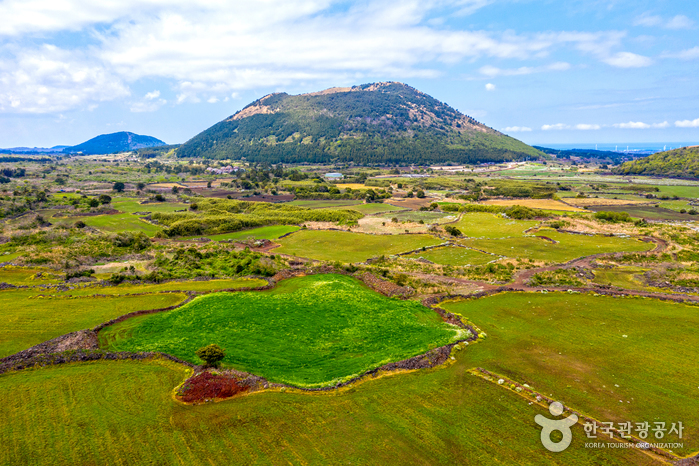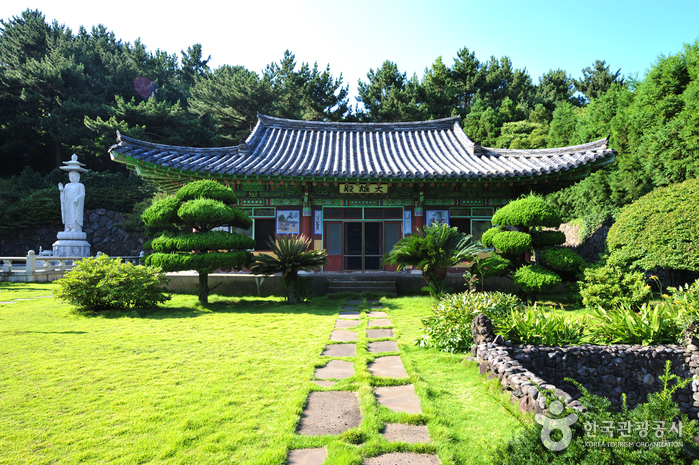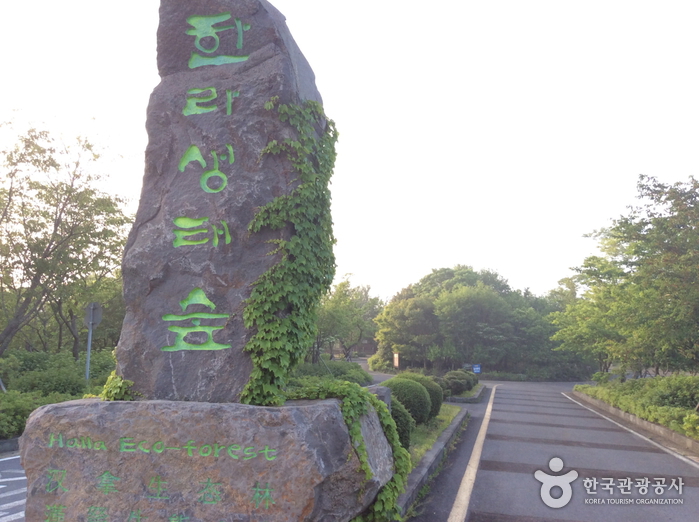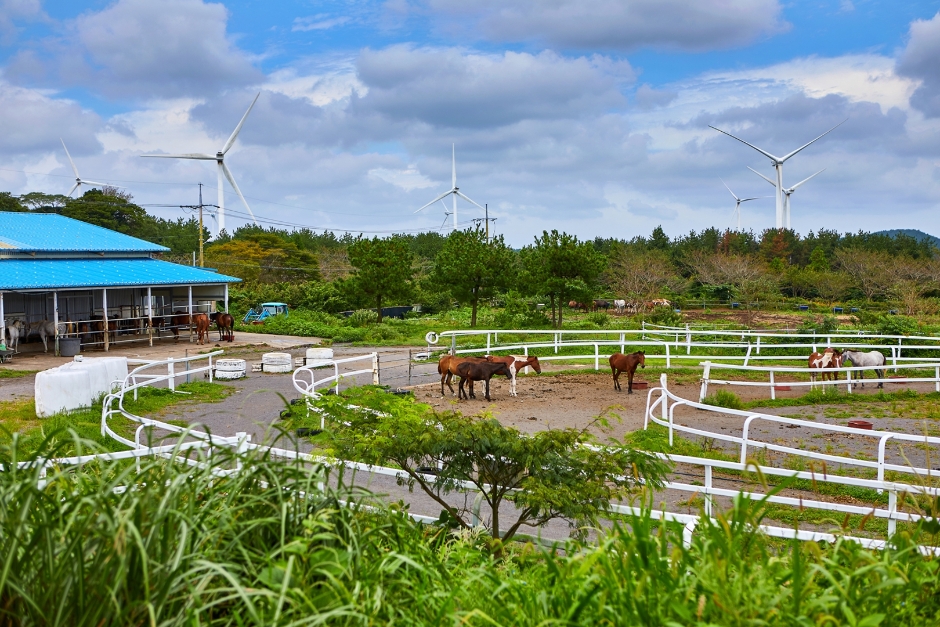Dangcheomuldonggul Cave [UNESCO World Natural Heritage Site] (당처물동굴 [유네스코 세계자연유산])
10.4Km 20850 2020-04-23
Woljeong-ri, Gujwa-eup, Jeju-si, Jeju-do
+82-1600-0064
Dangcheomuldonggul Cave, located in Jeju, is a lava tube estimated to have been formed some 320,000 years ago due to volcanic activity; it is located approximately 3 kilometers underground. With no entrance as such, the cave is not open to the general public and thus its original form remains preserved to this day, giving it a high geological value.
Although the Dangcheomuldonggul Cave is technically a lava tube, it resembles a limestone cave due to the secondary geological formations
of lime substances that have accumulated in the ground above the tube. The tunnel has a spectacular and mystical beauty with countless stalactites and stalagmites, as well as stalactite columns. The particularly thin stalactites and stalactic columns in this cave are well-known for their uniqueness and beauty. Although this is a relatively small lava tunnel, its exotic colors and the richness of the secondary topological formations make it extraordinary in terms of research value. This cave has been designated natural monument.
* The UNESCO World Heritage inscribed Geomun Oreum Lava Tube System consists of Bengdwigul, Manjanggul Cave, Gimnyeonggul, Yongcheondonggul and Dangcheomuldonggul Caves.
Darangswi Oreum (Wollangbong Peak) (다랑쉬오름(월랑봉))
10.4Km 15307 2020-05-06
San 6, Sehwa-ri, Jeju-si, Jeju-do
+82-64-740-6000
Located the Northeastern part of Jeju Island, Darangswi Oreum is a parasitic volcano that stands about 380 meters above sea level. From Darangswi Oreum, visitors can overlook tourist attractions such as Seongsan Ilchulbong (Sunrise Peak), Udo Island, Hallasan Mountain, coastlines, and various parasitic cones.
The mountain has an oval shape from south to north with a steep incline. The top has a large, deep funnel-shaped crater that still preserves its original shape unlike craters in cones. The name Darangswi is derived from the fact that the mountain looks like a moon ('Da' meaning 'Moon' and 'Swi' meaning 'Mountain' in the Jeju dialect).
Trees are scattered here and there at the top, and the outskirts of the mountain are decorated with cedar trees. Meadow plants such as Aster yomena populate most of the mountain. A gentle hill to the right of Darangswi Oreum is called Akkeun Darangswi Oreum (also called Sowol Nangak). Meaning 'small,' 'Akkeun' is both old Korean and Jeju dialect.
Darangswi Oreum hosts Wollang Peak Sunrise Festival every year allowing visitors to see the spectacular full moon from the crater. There are wooden stairs in place for easy ascent, and the mountain is also a popular site for paragliders.
Jeju Bultapsa Temple (불탑사(제주))
10.7Km 20793 2021-06-15
41, Wondang-ro 16-gil, Jeju-si, Jeju-do
+82-64-755-9283
Located in Samyang-dong, Jeju-si, Bultapsa Temple is a branch of Gwaneumsa Temple, the headquarters of the 23rd district of the Jogye Order of Korean Buddhism. The temple is nestled at the foot of Wondangbong Peak (alt. 170.4 meters). The temple started out as the Buddhist shrine Wondangsa, one of three temples in Jeju during the Yuan dynasty. Most of the temple was damaged due to the Jeju Uprising on April 3, 1948 and it was rebuilt in 1953. Later, the temple underwent renovations and extension works to get to the current conditions. Today, the temple has Daeungjeon Hall, Yosachae monk quarters, Jonggak Bell Tower, and Cheonwangmun Gate. The temple's five-story stone pagoda is Jeju's only stone pagoda from the Goryeo dynasty. It was designated Treasure No. 1187 in November 1993.
Woljeongri Beach (월정리해변(월정리해수욕장))
11.1Km 30958 2023-01-17
480-1, Haemajihaean-ro, Jeju-si, Jeju-do
+82-64-740-6000
Woljeong-ri, a village located on the east side of Jeju Island, holds the meaning "the moon stays." The beautiful emerald sea spreads out like a picture, and the bright moon shines above it. As more and more travelers visited the beach to appreciate its beauty, many restaurants, cafes, and lodging facilities started to form along the shoreline. Some cafes placed chairs for people to relax in while looking at the sea, which became an iconic photo spot of Woljeongri Beach.
The beach is also a popular location for a variety of water sports such as surfing, snorkeling, and kayaking. Woljeongri Beach is popular among surfers because it has waves with a uniform x_height that are constantly coming in. The beach is also a part of the Gimnyeong-Hado Olle and Gimnyeong-Woljeong Geotrail Course on Jeju Olle Trail Route 20, and a great spot for tourists to take a break while taking in the beautiful scenery and cool scent of the sea.
Halla Ecological Forest (한라생태숲)
11.4Km 23796 2021-06-11
2596, 516-ro, Jeju-si, Jeju-do
+82-64-710-8688
Spanning 196 hectares, Halla Ecological (Eco) Forest is home to 288,000 trees representing 333 indigenous plant species. Having been designated as a conservation area, the forest provides plenty of great opportunities to observe and learn about Jeju's diversified ecosystem through various facilities including an observatory, plant nurseries, walking trails, and more. The forest also features 13 themed forests with low-impact facilities to preserve the essence of the forest. Visitors can sign up for the forest experience program to enjoy the walking trails within the forest.
Lotte Himart - Samhwa Branch [Tax Refund Shop] (롯데하이마트 삼화점)
11.5Km 0 2024-04-19
888, Yeonsam-ro, Jeju-si, Jeju-do
-
Samyang Beach (삼양해수욕장)
11.6Km 37763 2022-07-28
Samyang 2-dong, Jeju-si, Jeju-do
+82-64-740-6000
Samyang Beach is cozy and has clear waters because it is not well-known among tourists. In particular, it stands out because of its sparkling black sand. As the black sand's therapeutic effect is well known, visitors can often be seen lying down on the beach and burying themselves in the black sand.
Yongnunioreum Volcanic Cone (용눈이오름)
11.6Km 20451 2024-03-15
28 Jongdal-ri, Gujwa-eup, Jeju-si, Jeju-do
+82-64-740-6000
Yongnunioreum Volcanic Cone is located in the eastern part of Jeju. It connects three craters and creates beautiful ridges. Its relatively low x_height makes reaching its summit easy. The top offers panoramic views of Seongsan Ilchulbong Tuff Cone and Udo Island in the distance. In spring and summer, the area is covered with green grass, while silver grass takes over in fall and winter.
Jeju Canola Flower Festival (제주 유채꽃축제)
11.8Km 76888 2023-03-17
381-17 , Noksan-ro, Seogwipo-si, Jeju-do
• 1330 Travel Hotline: +82-2-1330 (Korean, English, Japanese, Chinese) • For more info: +82-64-760-3942
The Jeju Canola Flower Festival is one of the most famous festivals in Jeju, bringing news of spring arrival with fields upon fields of bright yellow flowers. Large numbers of visitors come to the festival every year to take in this beauty. In addition to enjoying the vibrant landscape, visitors can participate in a variety of festival events that showcase the unique spirit of Jeju Island.
Jeju Horse Park (조랑말체험공원)
11.8Km 29658 2024-01-11
381-15 Noksan-ro, Seogwipo-si, Jeju-do
Jeju Horse Park offers a venue to promote Jeju’s horse culture in an easy and fun way. The park has kept intact the 600-year history of nomadic culture at the site of Gasi-ri Village which used to house Gammajang, the place for raising the best horses during the Joseon dynasty. The park includes the Jeju Horse Museum, Ttarabi horseback riding track, Maeum Cafe, Mongol Yurt Guesthouse, camping site, Art Shop, and an experience place to focus on the Project for a New Cultural Space Creation through the support of the Ministry of Agriculture, Food and Rural Affairs. The Jeju Horse Museum was the first national museum created by a village and its main theme covers the history and culture of the village. It is also regarded as a new form of community business model.




![Lotte Himart - Samhwa Branch [Tax Refund Shop] (롯데하이마트 삼화점)](http://tong.visitkorea.or.kr/cms/resource/64/2887664_image2_1.jpg)

 English
English
 한국어
한국어 日本語
日本語 中文(简体)
中文(简体) Deutsch
Deutsch Français
Français Español
Español Русский
Русский